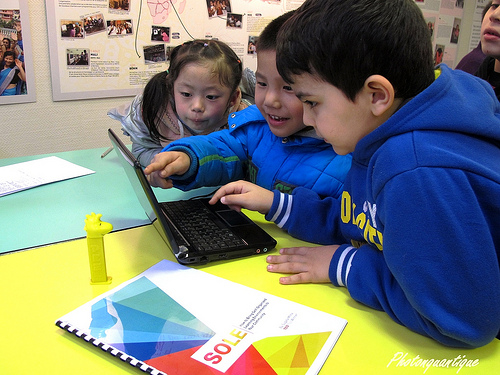
You can be a Paperless Classroom or a Blended Learning Classroom, but you can’t be both.
Over the past few weeks, I have had a couple of conversations with teachers and people in the business world that I just want to share with you and let you all tell me what you think about this idea.Â
There was…and still is…a push that when we go 1:1 in the classroom that this also means moving towards a paperless classroom…where everything is digital, done on a device and we cut paper out completely. From an environmental standpoint I totally get it. From a learning standpoint, I’m not so sure it’s the right move.Â
When we talk about a Blended Learning environment we’re talking about using the best physical stuff has to offer and the best that digital has to offer. It’s not about all of one or the other, but the blending of the physical world and the digital world. Knowing what, when and how to use all the tools at your disposal to create and learn from in the best the future has to offer.
Here’s what I haven’t found….I have not found one company that has gone paperless. Maybe there is one out there…I’m willing to say I haven’t checked with every company. But I have friends who work in tech and non-tech companies here in Seattle and other cities and not one of them lives in a paperless work environment. In fact, I have had people high up at both Amazon and Target tell me they print off the paper for meetings because people on their devices are A) distracting to others and B) distracting to the one’s self. By printing off the report or research they are working on, they do not have backs of screens between each of them and…get this….paper is easier to read.Â
It also reminds me of a story an 8th grade teacher told me a few years ago. She handed out a physical copy of the book the class was going to read and they thanked her. It shocked her that students wanted to touch, feel, and read a real book.Â
One of the things that makes me sad to see is when I walk into classrooms and students are reading a book, a report, or any other printed material that has been turned into a PDF for their screen. PDFs as a file type do not allow you to take advantage of an online dictionary and thesauruses. In most cases, they can’t be read out loud to the student. There is very little if any functionality you gained by taking something that was already on paper and turning into something that can be read on a screen that does not take advantage of the technology we have today to enhance the reading experience.Â
On the other side, everyone I know, have met or have talked to about this lives in a blended world. I take notes sometimes on my phone, sometimes on my computer, sometimes in my notebook. It depends where I am and what tools I have with me. I have a notebook I use to write down all the notes from each episode of these podcasts. I have another notebook I carry with me and write down all the notes during a meeting with school leaders before I come in for a day of training.Â
I start all my presentations on paper. I have a whole notebook full of my presentations before they ever make it to a slide deck. Just like Pixar storyboards out…on paper…ever movie before it’s created.Â
Paper and physical things in our classroom still have a place. I want to expose students to all of it. Going 1:1 shouldn’t limit the ways of creation in our classroom, they should enhance it. They should give students more options not fewer ones that are only digital.
If a student wants to take notes on paper they should have that option, if they want to take notes on a computer, they should have that option. What I want to make sure we do is expose students to all the ways you can take notes so they know how to choose the right tool for them for the right moment.
In the same way, I want to expose students to different ways of writing today. You can write on paper, you can write on your computer, or you can talk to your computer and it will write for you. Each one of these ways of writing has its advantages and disadvantages and that should be what our classrooms are about. Exposing students to all these different tools different ways to write, to read, to learn. I want students to be exposed to it all so they can choose for themselves as they move through school when is it best to use paper and when is it best to use a computer.Â
You can be a paperless classroom or a blended learning classroom but you can’t be both.






